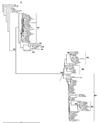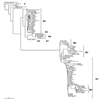Genetic diversity of the Kaposi's sarcoma herpesvirus K1 protein in AIDS-KS in Zimbabwe
- PMID: 18394954
- PMCID: PMC2556225
- DOI: 10.1016/j.jcv.2008.02.006
Genetic diversity of the Kaposi's sarcoma herpesvirus K1 protein in AIDS-KS in Zimbabwe
Abstract
Background: Kaposi's sarcoma-associated herpesvirus (KSHV) encodes genetically diverse K1 alleles which have unique geographic distributions. Little is known about K1 genetic diversity in Zimbabwe where acquired immunodeficiency syndrome-associated KS (AIDS-KS) is epidemic.
Objective: Evaluate K1 diversity in Zimbabwe and compare Zimbabwean K1 diversity to other areas in Africa.
Study design: K1 nucleotide sequence was determined for AIDS-KS cases in Zimbabwe. K1 references sequences were obtained from Genbank.
Results: Among 65 Zimbabwean AIDS-KS cases, 26 (40%) were K1 subtype A and 39 (60%) were subtype B. Zimbabwean subtype A sequences grouped only with African intratype A5 variants. Zimbabwean subtype B sequences grouped with multiple intratype African variants: 26 B1 (26%), four B3 (6%) and nine highly divergent B4 (14%). Zimbabwean subtype B had a lower synonymous to nonsynonymous mutation ratio (median 0.59 versus 0.66; P=0.008) and greater distance to the most recent common ancestor (median 0.03 versus 0.009; P<0.001) compared to subtype A. Within the B subgroup, the distribution of intratype B variants differed in Zimbabwe and Uganda (P=0.004).
Conclusions: Greater positive selection and genetic diversity in K1 subtype B compared to subtype A5 exist in Zimbabwe. However, there were no significant associations between K1 subtype and the clinical or demographic characteristics of AIDS-KS cases.
Figures




Similar articles
-
Variability and evolution of Kaposi's sarcoma-associated herpesvirus in Europe and Africa. International Collaborative Group.AIDS. 1999 Jul 9;13(10):1165-76. doi: 10.1097/00002030-199907090-00004. AIDS. 1999. PMID: 10416519
-
Molecular epidemiology of Kaposi's sarcoma-associated herpesvirus/human herpesvirus 8 strains from Russian patients with classic, posttransplant, and AIDS-associated Kaposi's sarcoma.J Med Virol. 2003 Dec;71(4):548-56. doi: 10.1002/jmv.10530. J Med Virol. 2003. PMID: 14556268
-
Molecular characterization of Kaposi's sarcoma associated herpesvirus (KSHV) from patients with AIDS-associated Kaposi's sarcoma in Sao Paulo, Brazil.J Clin Virol. 2005 May;33(1):52-9. doi: 10.1016/j.jcv.2004.09.026. J Clin Virol. 2005. PMID: 15797365
-
Kaposi's Sarcoma (KS)-associated herpesvirus and its role in KS.Infect Agents Dis. 1996 Oct;5(4):215-22. Infect Agents Dis. 1996. PMID: 8884366 Review.
-
Epidemiology and clinical characteristics of classic Kaposi's sarcoma, seroprevalence, and variants of human herpesvirus 8 in South America: a critical review of an old disease.Int J Infect Dis. 2005 Sep;9(5):239-50. doi: 10.1016/j.ijid.2005.02.004. Int J Infect Dis. 2005. PMID: 16095940 Review.
Cited by
-
Kaposi's Sarcoma-Associated Herpesvirus, the Etiological Agent of All Epidemiological Forms of Kaposi's Sarcoma.Cancers (Basel). 2021 Dec 9;13(24):6208. doi: 10.3390/cancers13246208. Cancers (Basel). 2021. PMID: 34944828 Free PMC article. Review.
-
Epidemiology and Genetic Variability of HHV-8/KSHV among Rural Populations and Kaposi's Sarcoma Patients in Gabon, Central Africa. Review of the Geographical Distribution of HHV-8 K1 Genotypes in Africa.Viruses. 2021 Jan 25;13(2):175. doi: 10.3390/v13020175. Viruses. 2021. PMID: 33503816 Free PMC article.
-
Genotypic analysis of Kaposi's sarcoma-associated herpesvirus from patients with Kaposi's sarcoma in Xinjiang, China.Viruses. 2014 Nov 26;6(12):4800-10. doi: 10.3390/v6124800. Viruses. 2014. PMID: 25431948 Free PMC article.
-
Multicentric Castleman disease in an HHV8-infected child born to consanguineous parents with systematic review.Pediatrics. 2012 Jan;129(1):e199-203. doi: 10.1542/peds.2010-2739. Epub 2011 Dec 12. Pediatrics. 2012. PMID: 22157133 Free PMC article. Review.
-
Seroprevalence and molecular diversity of Human Herpesvirus 8 among people living with HIV in Brazzaville, Congo.Sci Rep. 2021 Aug 31;11(1):17442. doi: 10.1038/s41598-021-97070-4. Sci Rep. 2021. PMID: 34465868 Free PMC article.
References
-
- Biggar RJ, Whitby D, Marshall V, Linhares AC, Black F. Human herpesvirus 8 in Brazilian Amerindians: hyperendemic population with a new subtype. J Infect Dis. 2000;181:1562–1568. - PubMed
-
- Boralevi F, Masquelier B, Denayrolles M, Dupon M, Pellegrin J–L, Ragnaud J–M, Fleury HJA. Study of human herpesvirus 8 (HHV-8) variants from Kaposi's sarcoma in France: Is HHV-8 subtype A responsible for more aggressive tumors? J Infect Dis. 1998;178:1546–1547. - PubMed
-
- Campbell TB, Borok M, White IE, Gudza I, Ndemera B, Taziwa A, Weinberg A, Gwanzura L. Relationship of Kaposi sarcoma (KS)-associated herpesvirus viremia and KS disease in Zimbabwe. Clin Infect Dis. 2003;36:1144–1151. - PubMed
-
- Chokunonga E, Levy IM, Bassett MT, Borok MZ, Manuchaza BG, Chirenje MZ, Parkin DM. AIDS and cancer in Africa: The evolving epidemic in Zimbabwe. AIDS. 1999;13:2583–2588. - PubMed
-
- Cook PM, Whitby D, Calabro ML, Luppi M, Kakoola DN, Hjalgrim H, Ariyoshi K, Ensoli B, Davidson AJ, Schultz TF the International Collaborative Group. Variability and evolution of Kaposi's sarcoma-associated herpes-virus in Europe and Africa. AIDS. 1999;13:1165–1176. - PubMed
Publication types
MeSH terms
Substances
Associated data
- Actions
- Actions
- Actions
- Actions
- Actions
- Actions
- Actions
- Actions
- Actions
- Actions
- Actions
- Actions
- Actions
- Actions
- Actions
- Actions
- Actions
- Actions
- Actions
- Actions
- Actions
- Actions
- Actions
- Actions
- Actions
- Actions
- Actions
- Actions
- Actions
- Actions
- Actions
- Actions
- Actions
- Actions
- Actions
- Actions
- Actions
- Actions
- Actions
- Actions
- Actions
- Actions
- Actions
- Actions
- Actions
- Actions
- Actions
- Actions
- Actions
- Actions
- Actions
- Actions
- Actions
- Actions
- Actions
- Actions
- Actions
- Actions
- Actions
- Actions
- Actions
- Actions
- Actions
- Actions
- Actions
- Actions
- Actions
Grants and funding
LinkOut - more resources
Full Text Sources
Medical

